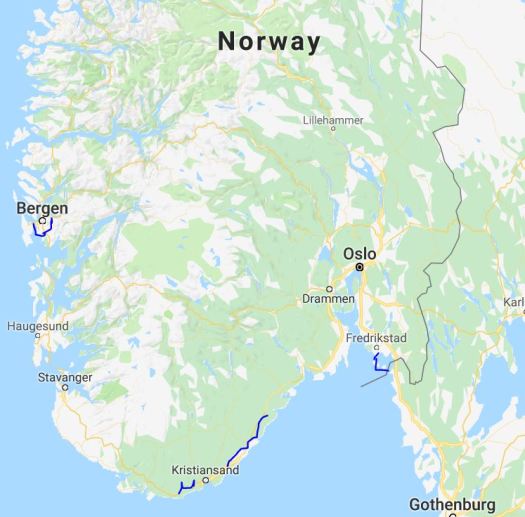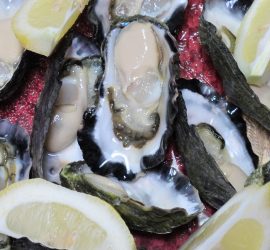
Oslo Fjord showcases the affinity that Norwegians have had with the sea over centuries. Not a fjord in the usual sense, this 100km stretch of water is peppered with small islands, lovely townships, historic ruins and thousands of those special little holiday spots that families treasure over generations.
On the south east side of the Oslo Fjord, around 94 kms south of Oslo, is the small city of Fredrikstad is steeped in history. Established in 1567, the old fortified town still demonstrates what life was like in medieval Scandinavia. Fredrikstad is also the launching pad for holiday makers to the Hvaler Islands, Norway’s sunniest area that consists of an amazing assortment of over 800 islands and almost-islands. There is truly something for everyone here in the spirit of a summer holiday. Culture, history, camping, hiking, swimming, fishing, sailing, kayaking, are all very popular. The area is easily accessed by car, train, and bus from Oslo. A series of roads and bridges connect the islands as do ferries, and once at your destination, hiring a bike is a fantastic way to see the islands up close.
Driving across from the mainland, the first major island is Vesterøy. With a number of quaint old fishing ports still bringing fresh seafood to the seafood market at Skjærhalden and south-eastern Norway’s largest fish processing centre in Utgårdskilen, nearby restaurants are guaranteed to have only the freshest fish and shellfish possible. Waterside dining here in company with those very extended Norwegian summer sunsets is a truly unforgettable experience.
The next island encountered is Spjærøy, known for is cultural attractions that include the coastal museum, picturesque Spjærøy Kirk, a granite church built in the 1880s, and off the southern tip of the island, Akerøya fort, built in the 17th century to defend the town of Fredrikstad. Beside that is Asmaløy , island which has wonderful hiking paths that take you across the island along the seaside tracks and to the many pretty little bays and secret coves that disappear into crystal clear water.
Kirkøy is the largest of the Hvaler islands, and has a large range of attractions. The hiking here is nothing short of superb with a diverse range of forest and coastal paths on offer. The centre of the region, Skjærhalden, is also located here and along with what you would expect from a busy summer hub in terms of cafes, restaurants, tourist services, and the full range of accommodation options. The Ytre Hvaler National Park Centre provides insight into the Ytre Hvaler National Park which covers the coast and the underwater realm of the Hvaler Islands, preserving unique and pristine ecosystems that include corals and marine life, wrecks, seals, and rich sea beds.
Southern Norway, or Sørlandet, is the Riviera of Norway. Except that for fresh seafood and wilderness value, it far eclipses any other Riviera experience anywhere else in the world. Where wilderness is concerned, magnificent old growth forests, mountains, rivers, lakes and the characteristically intricate Norwegian coastline wait to be explored. Picture-perfect villages, townships, ports and summer houses sit snug against clear-water bays with mountain backdrops, and tiny settlements hide within the numerous rocky islands. This is the traditional summer holiday destination. Activities here include swimming, camping, rafting, kayaking, boat hire, and freshwater and saltwater fishing. Boating is incredibly popular, and it’s a hikers dream for discovering and exploring tracks not usually part of the tourist brochures and not often seen, both in terms of coastal and mountain hiking. There are ski resorts in Winter, and due to the warm currents of the gulf stream that flood this coastline, swimming and diving are also attractions here in summer months. Getting to this part of Norway is relatively easy, with buses and trains from Oslo, a ferry from Hirtshals in Denmark, and an airport at Kristiansand, 65 kms from Arendal.
The regional centre for Southern Norway is lovely Arendal. The Trinity stately church, museums, architecture, and the old town of Arendal, Tyholmen, testify to the rich cultural heritage of the town, the heart of which today is Pollen Harbour, a lively social scene with cafes, bars, outdoor tables, shops and lots of summer people-watching. There is a fish market and the opportunity to buy crabs direct from the local fishermen as well. It’s not surprising that with such a rugged and dangerous coastline, this area needed some very important lighthouses. Store and Lille Torungen lighthouses marked the town for ships of old, and still provide a romantic sense of the lonely life of a keeper. Boat tours take you around the archipelago and to visit the island of Hisøy with it many little beaches, and bays, and famous white wooden church dating from the 1850s, the car-free island of Merdø, and the many smaller islands and skerries here.
Further along the coast south-west of Arendal there are a series of fairy-tale little villages and townships that look like they were made for creating postcards. Around 15km from Arendal is Fevik, with its little white beaches and cosy bathing areas. In the late 19th century, Fevik became one of the major boat building facilities in Europe. Traditional wooden water craft are still a feature of life here. The Strand Hotel stands out as a haven for travelers. Providing all the grandeur and luxury of 1930s fashion, it was a favourite retreat for Roald Dahl. With its many little doll-house, white wooden houses, red boat houses, cobbled streets, Grimstad is the jewel of the Sørlandet. Only 8kms from Fevik, nature just loves this area as well, and has gifted it with old-growth forests, clear peaceful waterways, beaches, and many little islands and skerries to explore. It is the perfect place to find inspiration, and no surprise that art and cultural events flourish in Grimstad. Great playwright and poet Henrik Ibsen spent his formative years here, and there is a beautiful museum dedicated to Ibsen and his work. Around 20km from Grimstad is Lillesand a larger town with a very rich history, which has survived various booms in shipping and fishing industries over centuries, and boasts the industrious nature of Norwegains. The Saltholmen lighthouse and beautiful swiss-chalet form of Lillesand Church declare the proud heritage of the town.
Coastal and forest hikes are abundant throughout this area. There are beautiful walks and trails to be found close to every town, and some are better known than others. In terms of the more popular trails here, 107km north-west of arendal is serene Nesvatn Lake. The Nesvatn Triangle hike showcases the magnificent forests of Southern Norway, skirting the lake and other bodies of water, with magnificent old cabins easily accessible plus terrific canoeing and fishing opportunities. Further inland from Lillesand, there is the lush Setesdal valley, which has hikes for all levels of ability, mountains, well marked trails, waterside cabins and tourist centres to provide detailed information on trails.
With so many perfect waterways, fish and fishermen also love Southern Norway. Fly-fishermen, the true artists of the fishing world, are in paradise. Atlantic salmon and brown trout thrive in the cool clear waters, and grayling and arctic char can also be caught. Other popular fish found here include pike, whitefish and redfin perch. The Nidelva River is the main river flowing into the region winding through mountains, dense forests and gorges some 220kms from its origins in the Telemark region, and absorbing many other rivers and streams in the process. Further west, the great Mandalselva , or Mandal river is Norway’s second largest, and is famous for its massive salmon run. For real salmon enthusiasts, a visit to the Kvåsfossen waterfall and salmon staircase viewing room in Lyngdal is a must.
Note that fishing seasons and rules must be observed, fishing seasons for trout and salmon for the river are generally between July and September and you need to get a fishing licence.
Bergen, on the wild west coast of Norway, is the gateway to the iconic scenery of Norway’s spectacular fjords and mountainlands. Dating from 1070, Bergen is Norway’s second largest city and still retains the character of an old Hanseatic League trading hub. Much of the city sits within fjords, surrounded by mountains. The city itself is beautiful too, from the old wharf district, Bryggen, with its picture-perfect Hanseatic architecture restored, and through the narrow cobblestone streets of the inner-town, to the traditional little shops and buzzing cafes with outdoor waterside tables. Seafood is certainly a big deal here. There is a wonderful fish market right beside the fjord which dates from the 1200s, and with the complete range of fresh local fish and shellfish, and a range of high-end and outdoor eateries featuring local seafood international and traditional dishes. Bergen is also the center of Norway’s important aquaculture industry, and hosts the Norwegian Institute of Marine Sciences, a fisheries museum, and a great aquarium too.
It is easy to get from the city to some of the landmark scenic delights of this area. Mount Fløyen provides magnificent views of the city and is easily accessible via the Fløibanen funicular which takes you up to the peak 320m above sea level. There are hiking options conveniently available here, including to tranquil Skomakerdiket lake, magic little body of water placed within the pristine mountain setting, and Mount Ulriken, the highest of Bergen’s famous seven mountains, which also has a cable car and a restaurant on the top of the mountain.
There are also a range of fjord cruises available from Norway into nearby fjord and traditional villages. One of the world’s greatest train rides joins Bergen and Oslo. This line if Europe’s highest train trip, wandering through 500km of Norwegian mountain wilderness, past lakes, along rivers and waterfalls, and to the incredible views of the remote village of Flåm, sitting high above the majestic valleys and fjords below.

